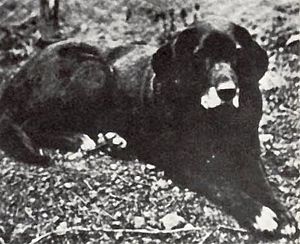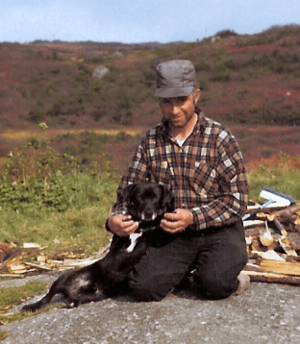St. John's water dog facts for kids

Nell, a St. John's water dog, c. 1856
|
|||||||||||||||||||||
| Other names | Lesser Newfoundland | ||||||||||||||||||||
|---|---|---|---|---|---|---|---|---|---|---|---|---|---|---|---|---|---|---|---|---|---|
| Origin | modern-day Canada | ||||||||||||||||||||
| Variety status | Extinct. Not recognized as a standardized breed by any major kennel club. | ||||||||||||||||||||
|
|||||||||||||||||||||
| Notes | The St. John's water dog first developed on the island of Newfoundland sometime between 1494-1790 as European fishing dogs were brought to the region. During its development, Newfoundland was being colonized by Europeans; while contested, Newfoundland was primarily a British colony until Canada was formed in 1867 and Newfoundland voted to join the country 1949. The dog went extinct in the 1980s. | ||||||||||||||||||||
| Domestic dog (Canis lupus familiaris) | |||||||||||||||||||||
The St. John's water dog was a special type of dog that came from Newfoundland, Canada. It's also known as the St. John's dog or the lesser Newfoundland. This dog breed is now extinct, meaning there are no more left.
We don't know exactly which dog breeds mixed to create them. They were likely a mix of old English, Irish, and Portuguese working dogs. Fishermen loved these dogs because they were friendly and great at their jobs. They were especially good at helping with fishing.
During the 1800s and early 1900s, St. John's water dogs were sent from Newfoundland to England. These dogs were then bred with other dogs to create the retrievers we know today. They are the ancestors of many modern retriever breeds. This includes the Flat-coated Retriever, Curly-coated Retriever, Chesapeake Bay Retriever, Golden Retriever, and Labrador Retriever. The St. John's water dog also helped create the large and gentle Newfoundland dog. This probably happened by breeding with Rafeiro do Alentejos. These dogs were brought to the island by Portuguese fishermen.
Their numbers started to drop in the early 1900s. By the early 1980s, they were completely gone.
Contents
What Did the St. John's Water Dog Look Like?
The St. John's water dogs were called "water dogs" for a good reason. They loved water and had a special coat that kept water out. They were medium-sized, strong, and sturdy. They looked more like English Labradors today than American ones.
These dogs often had white patches on their chest, chin, feet, and nose. This pattern is sometimes called "tuxedo markings." You can still see these white patches in some modern Labradors. Sometimes it's a small white spot on the chest, called a "medallion."
Writers from the 1600s mentioned strong, black dogs. These dogs would go with Newfoundland fishermen in their boats. They would help by retrieving fishing lines or nets. People described them as having a short, thick coat. They also had a tail that worked like a rudder in the water. These dogs had great energy and loved to swim.
When Did the St. John's Water Dog Live?
The St. John's water dog developed over many years. Here are some important dates in their history:
- 1494 or 1497: John Cabot landed on Newfoundland. Soon after, fishermen from Europe started visiting. They likely brought working dogs with them.
- 1536: Some fishermen began staying in Newfoundland all year. This might have been when dogs first lived there permanently.
- 1610: England set up the first official year-round settlement in Newfoundland. This made it more likely for dogs to live there permanently.
- 1630: St. John's became a permanent community. More people and dogs lived there year-round.
- 1790: The first drawing of a "Newfoundland dog" appeared. This dog might have been a St. John's dog. This shows the breed had likely formed by this time.
- 1809: Two St. John's puppies were on a ship that crashed near Maryland. These dogs mixed with local dogs. They helped create the Chesapeake Bay Retriever.
- 1814: A writer named Col. Peter Hawker described dogs from Newfoundland. He called the St. John's breed the "true Newfoundland." He said it was a medium-large dog with a smooth coat.
- 1822: Explorer W.E. Cormack wrote about the dogs. He said the short-haired dogs were best for retrieving. This was because ice didn't stick to their fur in cold weather.
- 1830: Another report described the dog as "by far the best for any kind of shooting." It was black, had short, smooth hair, and was very quick.
- 1839-1840: Geologist Joseph Beete Jukes described the St. John's water dog. He noted its thin snout, long tail, and powerful legs. He also saw one dog use its white foot to "entice" fish.
- 1867: Modern Canada was founded.
- 1885: The UK started a strict quarantine for all imported animals. This was to stop rabies. This made it hard to bring dogs from Newfoundland to the UK.
- 1949: Newfoundland officially joined Canada.
- 1980s: The last known St. John's water dogs were photographed.
Why Did the St. John's Water Dog Become Extinct?
The St. John's water dog disappeared for two main reasons. In Newfoundland, there were new rules and taxes on dog ownership. This was to encourage people to raise sheep instead. Also, the UK, which was a main place where these dogs were sent, started a strict quarantine in 1885. This rule made it very difficult to import any animals, especially dogs, to stop the spread of rabies.
The last two known St. John's water dogs were photographed in the early 1980s. They were old and lived in a very remote area. Sadly, both were male, so they couldn't have puppies. This meant the St. John's water dog breed came to an end.
In the 1970s, a Canadian writer named Farley Mowat tried to save them. He bred his St. John's water dog, named Albert, with a Labrador Retriever. They had four puppies, all with the white markings of their father. Two puppies died, and the other two were given away. One went to Canadian Prime Minister Pierre Trudeau. The other went to Soviet Premier Alexei Kosygin.
Images for kids
See also
 In Spanish: Perro de aguas de San Juan para niños
In Spanish: Perro de aguas de San Juan para niños




